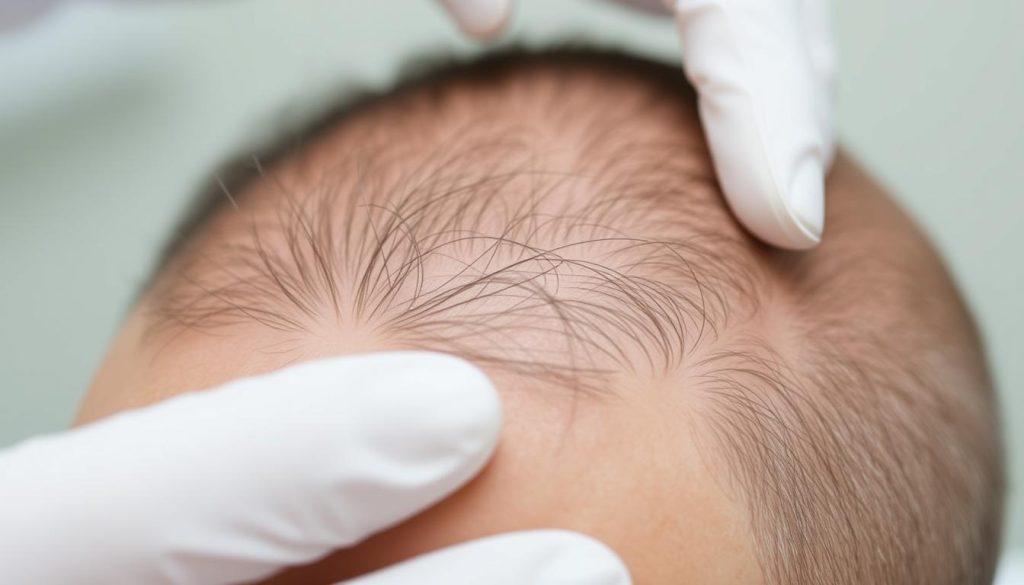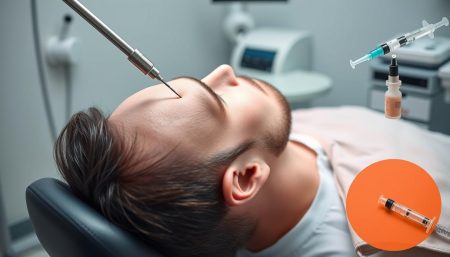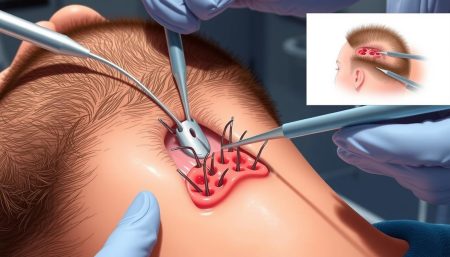Hair loss can really affect your confidence and how you see yourself. Luckily, modern hair transplant methods offer a way to get your natural hair back. These new techniques have changed the game, giving results that look very natural.
Today’s hair transplant methods use the latest technology and precise techniques. This means you can get hair that looks just like your own. Skilled surgeons move individual hair follicles to make your hair look full and healthy again.
In this guide, we’ll cover everything about hair transplantation. We’ll talk about the different procedures, who can get one, and what to expect. If you’re thinking about a hair transplant or just want to know more, this article is for you.
Understanding Modern Hair Transplant Procedures
Surgical hair restoration has made huge strides, giving natural results for those with hair loss. Let’s look at the latest techniques in modern hair transplants.
Follicular Unit Extraction (FUE) Technique
Follicular unit extraction is a gentle method. It takes individual hair follicles from the donor area. This method leaves tiny scars that are almost invisible. It’s perfect for those who like short hair.
Follicular Unit Transplantation (FUT) Method
Follicular unit transplantation removes a strip of scalp from the donor area. It lets surgeons transplant many grafts at once. This is great for those with a lot of hair loss.
Advanced Robotic Hair Restoration Systems
Robotic systems have changed hair transplants for the better. They improve precision and cut down on mistakes. These tools help surgeons pick and place grafts, leading to better results.
| Technique | Scarring | Recovery Time | Suitable For |
|---|---|---|---|
| FUE | Minimal | 1-2 weeks | Short hairstyles |
| FUT | Linear scar | 2-3 weeks | Extensive hair loss |
| Robotic | Minimal | 1-2 weeks | Precision-focused patients |
Each hair restoration method has its own benefits. They cater to different needs and preferences. Your surgeon will choose the best one for you, aiming for the most natural look.
The Science Behind Natural Hair Growth Patterns
Understanding how hair grows naturally is key to treating hair loss effectively. Trichology, the study of hair and scalp health, is very important. Hair grows in cycles, with each follicle going through growth, rest, and shedding phases.
The anagen phase is when hair grows, lasting 2-7 years. In this time, hair grows about 1 cm each month. Then, there’s a short catagen phase, followed by the telogen phase, where hair rests before falling out.
For natural-looking hair transplants, it’s vital to place grafts correctly and at the right angle. Surgeons consider several factors:
- Hair density
- Growth direction
- Distribution across the scalp
These factors help the transplanted hair look natural. Trichologists work with surgeons to get the best results. They check scalp health, find the right donor areas, and share insights on hair characteristics.
“The success of a hair transplant relies heavily on understanding and replicating natural growth patterns,” says Dr Sarah Thompson, a leading trichologist.
Using science, hair loss treatment experts can make transplants look natural. This way, patients get a fuller, younger look without any signs of surgery.
Evaluating Your Candidacy for a Hair Transplant
Figuring out if you’re right for a hair transplant is key for good results. A detailed check by a skilled expert is vital for your hair loss treatment.
Age and Hair Loss Pattern Considerations
Your age and how your hair falls out are important. The best candidates have a steady hair loss pattern. This usually happens after 25, making younger people less likely to be good candidates.
Donor Area Assessment
The quality and amount of hair you have in the back and sides matter a lot. Doctors look at these areas to see if there’s enough healthy hair for transplanting. Having a lot of hair here boosts your chances of a successful transplant.

Medical History Requirements
Your health affects how well a hair transplant works. Some health issues might make you not eligible. It’s important to share all your health history, including:
| Condition | Impact on Hair Transplant |
|---|---|
| Diabetes | May slow healing process |
| Autoimmune disorders | Can affect graft survival |
| Blood clotting issues | Increase risk during surgery |
| Scalp infections | Must be treated before procedure |
Thinking about these points helps you and your surgeon decide if a hair transplant is right for you. This ensures the best results for your alopecia treatment.
Planning Your Hair Transplant Journey
Starting a hair transplant journey needs careful planning. It begins with finding a good clinic and booking a first meeting. In this meeting, you’ll talk about what you want, check your hair loss, and look at treatment options.
It’s important to have realistic hopes for your hair transplant. Your surgeon will tell you when you’ll see results, which can take months. They’ll also give you advice on what to do before the surgery, like taking certain medicines and changing your lifestyle.
To get ready for your hair transplant, consider these steps:
- Look into different hair transplant methods
- Make a list of questions for your surgeon
- Make sure you have time off work for recovery
- Plan for after-care and follow-up visits
It’s also key to understand the cost of hair transplantation. Prices change based on how much hair you’ve lost and the method used. Many clinics have payment plans to help make it more affordable.
| Procedure Type | Average Cost Range | Recovery Time |
|---|---|---|
| FUE Hair Transplant | $4,000 – $15,000 | 1-2 weeks |
| FUT Hair Transplant | $4,000 – $10,000 | 2-3 weeks |
By planning well, you’ll feel more ready and excited for your hair transplant. Remember, it takes time to see the full results of your hair restoration.
Latest Technological Advances in Hair Restoration
The field of hair restoration has made huge strides in recent years. New technologies are changing surgical hair restoration. They give patients results that look more natural and better outcomes.
Digital Hair Design Planning
Modern clinics use advanced software for planning treatments. These tools help surgeons create detailed, custom plans. They figure out the best number and placement of grafts for a natural look.
Automated Graft Selection
AI systems have changed graft harvesting in hair restoration. They make the process more accurate and faster. This reduces graft damage and boosts transplant success.
Preservation Solutions Innovation
New ways to keep hair grafts alive have been developed. These solutions help grafts stay healthy longer. This means better results and more flexibility in scheduling.
| Technology | Benefit | Impact on Results |
|---|---|---|
| Digital Hair Design | Precise graft placement | More natural hairline |
| Automated Selection | Faster, more accurate harvesting | Higher graft survival rate |
| Advanced Preservation | Extended graft viability | Improved transplant success |
These new technologies have greatly improved hair restoration results. Patients now get more natural and pleasing results than ever.
The Step-by-Step Hair Transplant Procedure
A hair transplant procedure has many steps for natural-looking results. It starts with the surgeon marking the area and giving local anaesthesia. This makes sure the patient is comfortable.
For FUE, hair follicles are taken from the donor area with a special tool. FUT removes a strip of scalp from the donor area.
After taking the grafts, the team prepares them for transplant. They make tiny cuts in the recipient area, matching the natural hair growth. Then, they place the grafts in these cuts.
The time needed for a hair transplant depends on the method and number of grafts. FUE takes longer because it’s more detailed. Patients stay awake and can take breaks if needed.
“The key to a successful hair transplant lies in the precise placement of grafts to achieve a natural-looking hairline and density,” says Dr Sarah Thompson, a leading hair restoration specialist.
After the procedure, the surgeon gives detailed care instructions. Patients can go home the same day. They have follow-up appointments to check on their progress.
Recovery Timeline and Healing Process
Knowing how long it takes to recover and heal is key for those getting a hair transplant. This info helps manage expectations and ensures the right care after the surgery.
First Week Post-Operation
The first week is critical for a successful hair transplant. It’s important to avoid touching or scratching the area. Sleeping with your head higher can help with swelling.
Start gentle scalp washing on day three, as told by your surgeon.
Month-by-Month Progress
Hair growth after a transplant follows a clear pattern. In the first month, the transplanted hairs usually fall out. This is normal and makes room for new growth.
By the third month, tiny new hairs start to show. The sixth month is when you’ll see more hair growth and a fuller look.
Final Results Timeline
Being patient is important in hair loss treatment. Most people see the final results 12 to 18 months after the procedure. During this time, the hair will keep getting thicker and blending with your natural hair.
Regular check-ups with your surgeon are vital. They help ensure you’re healing well and address any issues quickly.
| Time Period | Expected Progress |
|---|---|
| 1-2 Weeks | Scabs heal, swelling subsides |
| 2-8 Weeks | Transplanted hairs shed |
| 3-6 Months | New hair growth begins |
| 6-12 Months | Hair thickens and matures |
| 12-18 Months | Final results visible |
Maximising Hair Transplant Results
After a hair transplant, patients can take steps to get the best results. It’s important to follow the post-operative care instructions carefully. This means washing your hair gently and avoiding activities that could harm the new grafts.
Other treatments can also improve your hair transplant results. For example, scalp micropigmentation can make your hair look thicker. If some areas can’t be transplanted, non-surgical hair replacement might be an option.
How you live your life also affects your hair transplant. Eating well and getting the right vitamins and minerals helps your hair grow. Reducing stress through meditation or exercise can also help your hair stay healthy.
| Factor | Impact on Hair Transplant Results |
|---|---|
| Nutrition | Supports hair growth and strength |
| Stress Management | Reduces hair loss and improves overall health |
| Proper Hair Care | Maintains transplanted hair and prevents damage |
Using special hair care products for transplanted hair is also key. These products have ingredients that feed your scalp and help your hair grow.
By following these tips and working with your surgeon, you can get the best results from your hair transplant.
Cost Considerations and Financial Planning
Understanding the financial side of a hair transplant is key for those thinking about it. The cost can change a lot based on different things. So, it’s important to plan well ahead.
Procedure Price Breakdown
The cost of a hair transplant depends on the method, how many grafts you need, and the surgeon’s skill. In the United States, prices range from £3,000 to £15,000. Here’s a simple guide to average prices:
| Procedure Type | Average Cost Range | Factors Influencing Price |
|---|---|---|
| FUE (Follicular Unit Extraction) | £4,000 – £15,000 | Number of grafts, clinic location |
| FUT (Follicular Unit Transplantation) | £3,000 – £10,000 | Strip size, surgeon experience |
| Robotic Hair Transplant | £5,000 – £18,000 | Technology used, clinic reputation |
Insurance Coverage Options
Most insurance plans don’t cover hair transplants because they’re seen as cosmetic. But, some policies might cover it if hair loss is due to illness or injury. It’s a good idea to check with your provider to see what you might be covered for.
Financing Solutions
Many clinics have financing plans to help make hair transplants more affordable. These might include:
- Monthly payment plans
- Medical credit cards
- Personal loans
When looking at financing, it’s smart to compare interest rates and terms. This way, you can find the best option for your budget.
While cost is important, it shouldn’t be the only thing you think about when choosing a hair transplant provider. Quality and experience are also key for getting natural-looking results.
Choosing the Right Hair Transplant Surgeon
Finding a skilled hair transplant surgeon is key for natural-looking results. Your choice greatly affects the success of your surgery. Begin by checking the surgeon’s qualifications, like their training and certifications.
Check if they belong to groups like the International Society of Hair Restoration Surgery. Being part of these groups shows they follow high standards and keep learning.
Look at the surgeon’s before-and-after photos. These show their skill and taste. Also, read what past patients say about the surgeon’s skills and how they were treated.
“A face-to-face consultation is essential. It allows you to assess the surgeon’s communication style and their ability to create a personalised treatment plan.”
Talk about what you want from your hair transplant during your meeting. A good surgeon will give honest advice and tell you what’s possible.
Watch out for warning signs like:
- Unrealistic promises of results
- Pressure to make a quick decision
- Reluctance to discuss possible risks or problems
- No before-and-after photos or references from past patients
By doing your homework and carefully choosing, you can find the right surgeon. The right one can greatly improve your chances of getting the natural hair you want.
Potential Risks and Complications
Hair transplant and restoration have made big strides. Yet, they carry risks like any medical treatment. It’s key to know these risks if you’re thinking about a hair transplant.
Common Side Effects
Most people face mild side effects after a hair transplant. These include:
- Swelling around the forehead and eyes
- Redness at the transplant site
- Mild discomfort or pain
- Temporary numbness in treated areas
These side effects usually go away in a week or two.
Long-term Considerations
Though rare, some long-term issues can happen:
| Complication | Description | Frequency |
|---|---|---|
| Scarring | Visible marks at donor or recipient sites | Uncommon |
| Infection | Bacterial growth at surgical sites | Rare |
| Unnatural appearance | Pluggy or uneven hair growth | Rare with experienced surgeons |
Prevention Strategies
To lower risks, follow these tips:
- Choose a qualified, experienced hair restoration surgeon
- Disclose your full medical history
- Follow all pre and post-operative instructions carefully
- Attend all follow-up appointments
By taking these steps, you can greatly reduce risks. This way, you can enjoy the benefits of your hair transplant.
Post-Transplant Hair Care Guidelines
Proper care after a hair transplant is key for successful hair restoration. These guidelines will help protect your new hair and boost your hair loss treatment’s effectiveness.
In the first week after surgery, gentle care is essential. Avoid touching or scratching the transplanted area. Use a soft, sulphate-free shampoo as directed by your surgeon.
As healing progresses, keep your hair care gentle. Wash with lukewarm water and dry with a soft towel. Stay away from harsh chemicals, heat styling, and too much sun to protect your new hair.
- Use a wide-toothed comb to detangle hair gently
- Apply a mild, alcohol-free moisturiser to keep the scalp hydrated
- Wear a loose-fitting hat when outdoors to shield from UV rays
Long-term care is vital for keeping your hair restoration results. Stick to gentle hair products. Also, consider adding special treatments for transplanted hair to your routine.
| Timeline | Care Instructions |
|---|---|
| Week 1-2 | Minimal touching, gentle cleansing |
| Months 1-3 | Gradual return to normal hair care routine |
| 6+ Months | Regular maintenance, protective styling |
By following these post-transplant care guidelines, you’ll ensure the best outcome for your hair restoration. Enjoy natural-looking, healthy hair for years to come.
Combining Treatments for Optimal Results
Getting the best results from hair loss treatment often means using more than one method. By mixing different strategies, people can increase their chances of success. This helps keep their hair healthy for a long time.
Medication Options
Using medications with a hair transplant can make results better. FDA-approved drugs like finasteride and minoxidil slow down hair loss and help new hair grow. These medicines work well when used with surgery.
Supplementary Therapies
Non-surgical hair replacement methods can also improve transplant results. Platelet-rich plasma (PRP) therapy, for example, boosts hair follicles and improves scalp health. Low-level laser therapy is another option that helps hair grow thicker and fuller.
Lifestyle Modifications
Looking at hair care as a whole is key. Eating a balanced diet full of vitamins and minerals helps hair grow. Stress management, like meditation or yoga, also helps keep hair healthy. Plus, gentle hair care and avoiding harsh chemicals are important for scalp health.
| Treatment Type | Benefits | Considerations |
|---|---|---|
| Medications | Slows hair loss, promotes new growth | Requires consistent use |
| PRP Therapy | Stimulates follicles, improves scalp health | Multiple sessions needed |
| Laser Therapy | Encourages hair growth and thickness | Long-term commitment required |
| Diet & Stress Management | Supports overall hair health | Lifestyle changes necessary |
By combining these methods, patients can make a treatment plan that fits their needs. This way, they can get the best, natural-looking results.
Long-term Maintenance Strategies
Keeping your hair looking great after a transplant is key. Good care and follow-up treatments help your transplant last longer. They also tackle ongoing hair loss.
It’s important to see your hair loss specialist regularly. These visits help track your transplant’s success and spot any problems early. Your doctor might suggest extra treatments to keep your hair looking natural.
Other treatments can make your hair look fuller. For example, scalp micropigmentation adds colour to thin spots. You might also consider non-surgical hair replacement for better results.
- Use gentle hair care products
- Protect your scalp from sun damage
- Maintain a healthy diet rich in vitamins and minerals
- Consider prescribed medications to slow further hair loss
It’s important to manage your expectations. As you age, your hair will change. Working with your specialist helps you stay confident in your look for years.
| Maintenance Strategy | Frequency | Benefits |
|---|---|---|
| Check-ups with specialist | Every 6-12 months | Monitor progress, address concerns |
| Touch-up procedures | As needed | Maintain natural appearance |
| Scalp care routine | Daily | Promote healthy hair growth |
| Nutritional support | Ongoing | Strengthen existing hair |
Real Patient Success Stories and Results
Hair transplant procedures have changed many lives, boosting confidence and self-esteem. People of all ages, genders, and hair types have seen amazing results. These stories prove how effective modern hair restoration is.
A 42-year-old executive had a Follicular Unit Extraction (FUE) procedure. He said, “The transplant completely changed my outlook. I feel younger and more confident in both my personal and professional life.” His before-and-after photos show a natural-looking hairline and more hair, proving the power of hair restoration.
A 35-year-old woman also had a success story. She had thinning hair due to hormonal issues. After her transplant, she said, “I never thought I’d feel comfortable wearing my hair down again. Now, I love styling my full head of hair.” Her story shows how important a tailored treatment plan is for great results.
While everyone’s experience is different, these stories show the impact of hair transplants. People should have realistic hopes and talk to experts to find the right solution for them.
FAQ
Q: What is a hair transplant?
A: A hair transplant moves hair follicles from a donor area to bald spots. It aims to grow hair and look natural.
Q: How long does a hair transplant procedure take?
A: A hair transplant’s time varies by technique and grafts needed. It usually takes 4 to 8 hours for one session.
Q: What is the difference between FUE and FUT?
Follicular Unit Extraction (FUE) takes single follicles from the donor area. Follicular Unit Transplantation (FUT) removes a scalp strip. FUE is less invasive, FUT can transplant more in one go.
Q: How long does it take to see results from a hair transplant?
A: Results start showing 3-4 months after. But, it takes 12-18 months to see the full effect.
Q: Are hair transplant results permanent?
A: Transplanted hair is usually permanent. But, hair loss can continue in other areas, needing more treatments.
Q: Who is an ideal candidate for a hair transplant?
A: Good candidates have stable hair loss, enough donor hair, and realistic hopes. Age, health, and hair loss cause matter too.
Q: How much does a hair transplant cost?
A: Hair transplant costs vary. It depends on the method, grafts, and surgeon’s skill. Prices range from £3,000 to £15,000 or more.
Q: What are the possible risks and side effects of a hair transplant?
A: Side effects include swelling, redness, and minor pain. Serious but rare issues are infection, scarring, or bad results. Always talk about risks with a surgeon.
Q: How do I choose the right hair transplant surgeon?
A: Choose a board-certified surgeon with lots of experience. They should show before-and-after photos. A face-to-face meeting is key to see if they’re right for you.
Q: Can women undergo hair transplants?
A: Yes, women can get hair transplants. But, female hair loss is different. A specialist must evaluate to see if it’s right for you.
Q: What is the recovery process like after a hair transplant?
A: Recovery means avoiding hard work for a week or two. You’ll need to follow hair care rules. Most can go back to work in a few days.
Q: Are there any non-surgical alternatives to hair transplants?
A: Yes, there are non-surgical options. These include medicines, platelet-rich plasma (PRP) therapy, laser therapy, and scalp micropigmentation. They can be used alone or with transplants for best results.


















